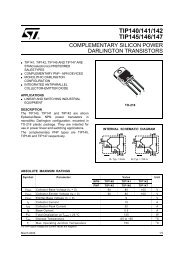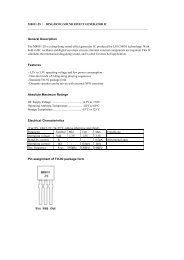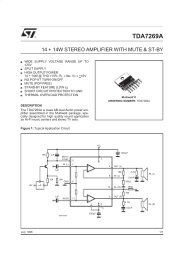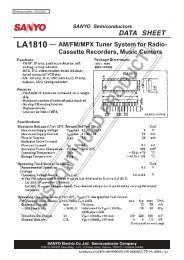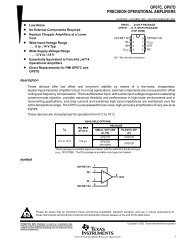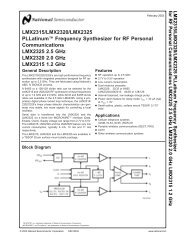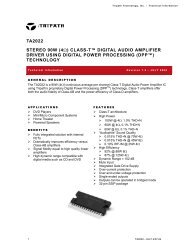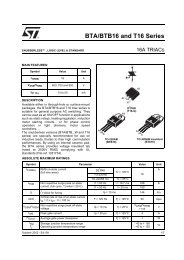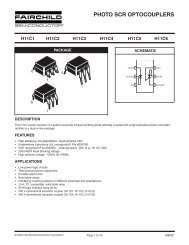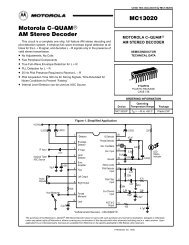Create successful ePaper yourself
Turn your PDF publications into a flip-book with our unique Google optimized e-Paper software.
®<br />
<strong>TDA2005</strong><br />
20W BRIDGE AMPLIFIER FOR CAR RADIO<br />
High output power : PO = 10 + 10 W@RL =2Ω,<br />
d = 10% ; P O = 20W@R L =4Ω,d=1%.<br />
High reliability of the chip and package with additional<br />
.<br />
complete safety during operation thanks to<br />
protection against :<br />
OUTPUT DC AND AC SHORT CIRCUIT TO<br />
GROUND<br />
OVERRATING CHIP TEMPERATURE<br />
.<br />
LOAD DUMP VOLTAGE SURGE<br />
FORTUITOUS OPEN GROUND<br />
VERY INDUCTIVE LOADS<br />
Flexibility in use : bridge or stereo booster amplifiers<br />
with or without boostrapand with programmable<br />
gain and bandwidth.<br />
Space and cost saving : very low number of<br />
external components, very simple mounting system<br />
with no electrical isolation between the package<br />
and the heatsink (one screw only).<br />
In addition, the circuit offers loudspeaker protection<br />
during short circuit for one wire to ground.<br />
ABSOLUTE MAXIMUM RATINGS<br />
PIN CONNECTION<br />
MULTIWATT11<br />
ORDERING NUMBERS : <strong>TDA2005</strong>M (Bridge Appl.)<br />
<strong>TDA2005</strong>S (Stereo Appl.)<br />
DESCRIPTION<br />
The <strong>TDA2005</strong> is class B dual audio power amplifier<br />
in MULTIWATT® packagespecifically designed for<br />
car radio application : power booster amplifiers<br />
are easily designed using this device that provides<br />
a high current capability (up to 3.5 A) and that can<br />
drive very low impedance loads (down to 1.6Ω in<br />
Symbol Parameter Value Unit<br />
V s Operating Supply Voltage 18 V<br />
V s DC Supply Voltage 28 V<br />
V s Peak Supply Voltage (for 50 ms) 40 V<br />
I o (*) Output Peak Current (non repetitive t = 0.1 ms) 4.5 A<br />
I o (*) Output Peak Current (repetitive f ≥ 10 Hz) 3.5 A<br />
P tot Power Dissipation at T case =60°C 30 W<br />
T stg , T j Storage and Junction Temperature – 40 to 150 °C<br />
(*) The max. output current is internally limited.<br />
11<br />
10<br />
9<br />
8<br />
7<br />
6<br />
5<br />
4<br />
3<br />
2<br />
1<br />
BOOTSTRAP(1)<br />
OUTPUT(1)<br />
+V S<br />
OUTPUT(2)<br />
BOOTSTRAP(2)<br />
GND<br />
INPUT+(2)<br />
INPUT-(2)<br />
SVRR<br />
INPUT-(1)<br />
INPUT+(1)<br />
TAB CONNECTED TO PIN 6<br />
D95AU318<br />
October 1998<br />
1/20
<strong>TDA2005</strong><br />
SCHEMATIC DIAGRAM<br />
THERMAL DATA<br />
Symbol Parameter Value Unit<br />
Rth j-case Thermal Resistance Junction-case Max. 3 °C/W<br />
2/20
<strong>TDA2005</strong><br />
BRIDGE AMPLIFIER APPLICATION (<strong>TDA2005</strong>M)<br />
Figure 1 : Test and Application Circuit (Bridge amplifier)<br />
Figure 2 : P.C. Board and Components Layout of Figure 1 (1:1 scale)<br />
3/20
<strong>TDA2005</strong><br />
ELECTRICAL CHARACTERISTICS (refer to the Bridge applicationcircuit, Tamb =25 o C, GV = 50dB,<br />
Rth (heatsink) =4 o C/W, unless otherwise specified)<br />
Symbol Parameter Test Conditions Min. Typ. Max. Unit<br />
V s Supply Voltage 8 18 V<br />
V os Output Offset Voltage (1)<br />
(between pin 8 and pin 10)<br />
V s = 14.4V<br />
V s = 13.2V<br />
Id Total Quiescent Drain Current V s = 14.4V R L =4Ω<br />
Vs= 13.2V RL = 3.2Ω<br />
P o Output Power d = 10% f = 1 Hz<br />
V s = 14.4V R L =4Ω<br />
R L = 3.2Ω<br />
V s = 13.2V R L = 3.2 Ω<br />
d Distortion f = 1kHz<br />
V s = 14.4V R L =4Ω<br />
P o = 50mW to 15W<br />
V s = 13.2V R L = 3.2Ω<br />
P o = 50mW to 13W<br />
V i Input Sensitivity f = 1kHz<br />
Po =2W RL =4Ω<br />
P o =2W R L = 3.2Ω<br />
R i Input Resistance f = 1kHz 70 kΩ<br />
f L Low Frequency Roll Off (– 3dB) R L = 3.2Ω 40 Hz<br />
f H High Frequency Roll Off (– 3dB) R L = 3.2Ω 20 kHz<br />
G v Closed Loop Voltage Gain f = 1kHz 50 dB<br />
e N Total Input Noise Voltage R g = 10kΩ (2) 3 10 µV<br />
SVR Supply Voltage Rejection R g = 10kΩ, C 4 =10µF<br />
f ripple = 100Hz, V ripple = 0.5V<br />
45 55 dB<br />
η Efficiency V s = 14.4V, f = 1 kHz<br />
P o = 20W R L =4Ω<br />
P o = 22W R L = 3.2Ω<br />
Vs = 13.2V, f = 1 kHz<br />
Po = 19W RL = 3.2Ω<br />
T j Thermal Shut-down Junction<br />
Temperature<br />
V OSH Output Voltage with one Side of<br />
Notes : 1. the For Speaker <strong>TDA2005</strong>M shorted only to ground<br />
2. Bandwith Filter :22Hz to 22kHz.<br />
V s = 14.4V, R L =4Ω<br />
f = 1kHz, P tot = 13W<br />
18<br />
20<br />
17<br />
75<br />
70<br />
20<br />
22<br />
19<br />
9<br />
8<br />
60<br />
60<br />
58<br />
150<br />
150<br />
150<br />
160<br />
1<br />
1<br />
mV<br />
mV<br />
mA<br />
mA<br />
W<br />
%<br />
%<br />
mV<br />
mV<br />
%<br />
%<br />
%<br />
145 °C<br />
V s = 14.4V R L =4Ω<br />
V s = 13.2V R L = 3.2Ω 2 V<br />
4/20
<strong>TDA2005</strong><br />
Figure 3 :<br />
Output Offset Voltage versus<br />
Supply Voltage<br />
Figure 4 :<br />
Distortion versus Output Power<br />
(bridge amplifier)<br />
Figure 5 :<br />
Distortion versus Output Power<br />
(bridge amplifier)<br />
BRIDGE AMPLIFIER DESIGN<br />
The following consideraions can be useful when designing a bridge amplifier.<br />
V omax<br />
I o max<br />
P omax<br />
Where :<br />
Parameter Single Ended Bridge<br />
Peak Output Voltage (before clipping)<br />
Peak Output Current (before clippling)<br />
RMS Output Power (before clipping)<br />
VCE sat = output transistors saturation voltage<br />
VS = allowable supply voltage<br />
RL = load impedance<br />
1<br />
2 (V s –2V CE sat ) V s –2V CE sat<br />
1 VS − 2V CE sat<br />
2 R L<br />
V S − 2V CE sat<br />
R L<br />
1 (V S − 2V CE sat ) 2 (V S −2V CE sat ) 2<br />
4 2R L 2R L<br />
5/20
<strong>TDA2005</strong><br />
Voltage and current swings are twice for a bridge<br />
amplifier in comparison with single endedamplifier.<br />
In order words, with the same RL the bridge configuration<br />
can deliver an output power that is four<br />
times the output power of a single ended amplifier,<br />
while, with the same max output current the bridge<br />
configuration can deliver an output power that is<br />
twice the output power of a single ended amplifier.<br />
Core must be taken when selecting VS and RL in<br />
order to avoid an output peak current above the<br />
absolute maximum rating.<br />
From the expression for IOmax, assuming VS<br />
= 14.4V and VCE sat = 2V, the minimum load that<br />
can be driven by <strong>TDA2005</strong> in bridge configuration<br />
is :<br />
RL min = V S − 2V CEsat<br />
I Omax<br />
=<br />
14.4 −4<br />
3.5<br />
= 2.97Ω<br />
The voltagegainof thebridge configurationisgiven<br />
by (see Figure 34) :<br />
G V = V 0 R 1<br />
=1+<br />
V 1<br />
⎛<br />
⎜<br />
⎝<br />
+ R 3<br />
R 2 ⋅R 4 ⎞ R 4<br />
R 2 +R ⎟⎠ 4<br />
Forsufficiently high gains (40 to 50dB) it is possible<br />
to put R2 =R4and R3 =2R1, simplifing the formula<br />
in :<br />
GV =4 R 1<br />
R 2<br />
G v (dB) R 1 (Ω) R 2 =R 4 (Ω) R 3 (Ω)<br />
40<br />
50<br />
1000<br />
1000<br />
39<br />
12<br />
Figure 6 : Bridge Configuration<br />
2000<br />
2000<br />
STEREO AMPLIFIER APPLICATION (<strong>TDA2005</strong>S)<br />
Figure 7 : Typical Application Circuit<br />
6/20
<strong>TDA2005</strong><br />
ELECTRICAL CHARACTERISTICS (refer to the Stereo application circuit, Tamb =25 o C, GV = 50dB,<br />
Rth (heatsink) =4 o C/W, unless otherwwise specified)<br />
Symbol Parameter Test Conditions Min. Typ. Max. Unit<br />
V s Supply Voltage 8 18 V<br />
V o Quiescent Output Voltage V s = 14.4V<br />
V s = 13.2V<br />
Id Total Quiescent Drain Current Vs = 14.4V<br />
V s = 13.2V<br />
P o Output Power (each channel) f = 1kHz, d = 10%<br />
V s = 14.4V R L =4Ω<br />
R L = 3.2Ω<br />
R L =2Ω<br />
R L = 1.6Ω<br />
V s = 13.2V R L = 3.2Ω<br />
R L = 1.6Ω<br />
V s = 16V R L =2Ω<br />
d Distortion (each channel) f = 1kHz<br />
V s = 14.4V R L =4Ω<br />
P o = 50mW to 4W<br />
V s = 14.4V R L =2Ω<br />
P o = 50mW to 6W<br />
V s = 13.2V R L = 3.2Ω<br />
Po = 50mW to 3W<br />
V s = 13.2V R L = 1.6Ω<br />
P o = 40mW to 6W<br />
CT Cross Talk (1) V s = 14.4V, V o =4V RMS<br />
R L =4Ω,R g =5kΩ<br />
f = 1kHz<br />
f = 10kHz<br />
V i Input Saturation Voltage 300 mV<br />
V i Input Sensitivity f = 1kHz, P o =1W<br />
RL=4Ω<br />
R L = 3.2Ω<br />
R i Input Resistance f = 1kHz 70 200 kΩ<br />
f L Low Frequency Roll Off (– 3dB) RL =2Ω 50 Hz<br />
f H High Frequency Roll Off (– 3dB) R L =2Ω 15 kHz<br />
G v Voltage Gain (open loop) f = 1kHz 90 dB<br />
G v Voltage Gain (closed loop) f = 1kHz 48 50 51 dB<br />
∆ G v Closed Loop Gain Matching 0.5 dB<br />
e N Total Input Noise Voltage R g = 10kΩ (2) 1.5 5 µV<br />
SVR Supply Voltage Rejection R g = 10kΩ, C 3 =10µF<br />
f ripple = 100Hz, V ripple = 0.5V<br />
35 45 dB<br />
η Efficiency V s = 14.4V, f = 1kHz<br />
P o = 6.5W R L =4Ω<br />
P o = 10W R L =2Ω<br />
Vs= 13.2V, f = 1kHz<br />
Po = 6.5W RL = 3.2Ω<br />
Po = 100W RL = 1.6Ω<br />
Notes : 1. For <strong>TDA2005</strong>M only<br />
2. Bandwith Filter :22Hz to 22kHz.<br />
6.6<br />
6<br />
6<br />
7<br />
9<br />
10<br />
6<br />
9<br />
7.2<br />
6.6<br />
65<br />
62<br />
6.5<br />
8<br />
10<br />
11<br />
6.5<br />
10<br />
12<br />
0.2<br />
0.3<br />
0.2<br />
0.3<br />
60<br />
45<br />
6<br />
5.5<br />
70<br />
60<br />
70<br />
60<br />
7.8<br />
7.2<br />
120<br />
120<br />
1<br />
1<br />
1<br />
1<br />
V<br />
V<br />
mA<br />
mA<br />
W<br />
%<br />
%<br />
%<br />
%<br />
dB<br />
mV<br />
%<br />
%<br />
%<br />
%<br />
7/20
<strong>TDA2005</strong><br />
Figure 8 :<br />
Quiescent Output Voltage versus<br />
Supply Voltage (Stereo amplifier)<br />
Figure 9 :<br />
Quiescent Drain Current versus<br />
Supply Voltage (Stereo amplifier)<br />
Figure 10 : Distortion versus Output Power<br />
(Stereo amplifier)<br />
Figure 11 : Output Power versus Supply Voltage<br />
(Stereo amplifier)<br />
Figure 12 : Output Power versus Supply Voltage<br />
(Stereo amplifier)<br />
Figure 13 : Distortion versus Frequency<br />
(Stereo amplifier)<br />
8/20
<strong>TDA2005</strong><br />
Figure 14 : Distortion versus Frequency<br />
(Stereo amplifier)<br />
Figure 15 : Supply Voltage Rejection versus C3<br />
(Stereo amplifier)<br />
Figure 16 : Supply Voltage Rejection versus<br />
Frequency (Stereo amplifier)<br />
Figure 17 : Supply Voltage Rejection versus<br />
C2 and C3 (Stereo amplifier)<br />
Figure 18 : Supply Voltage Rejection versus<br />
C2 and C3 (Stereo amplifier)<br />
Figure 19 : Gain versus Input Sensitivity<br />
(Stereo amplifier)<br />
9/20
<strong>TDA2005</strong><br />
Figure 20 : Gain versus Input Sensitivity<br />
(Stereo amplifier)<br />
Figure 21 : Total Power Dissipation and Efficiency<br />
versus Output Power<br />
(Bridge amplifier)<br />
Figure 22 : Total Power Dissipation and Efficiency<br />
versus Output Power<br />
(Stereo amplifier)<br />
10/20
<strong>TDA2005</strong><br />
APPLICATION SUGGESTION<br />
The recommended values of the components are those shown on Bridge applicatiion circuit of Figure 1.<br />
Different values can be used ; the following table can help the designer.<br />
Comp.<br />
Recom.<br />
Value<br />
Purpose Larger Than Smaller Than<br />
R 1 120 kΩ Optimization of the Output<br />
Symmetry<br />
Smaller P o max<br />
Smaller P o max<br />
R 2<br />
R3<br />
1kΩ<br />
2kΩ<br />
R 4 ,R 5 12 Ω Closed Loop Gain Setting (see<br />
Bridge Amplifier Design) (*)<br />
R6, R7 1Ω Frequency Stability Danger of Oscillation at High<br />
Frequency with Inductive Loads<br />
C 1 2.2 µF Input DC Decoupling<br />
C 2 2.2 µF Optimization of Turn on Pop and<br />
Turn on Delay<br />
High Turn on Delay<br />
Higher Turn on Pop, Higher<br />
Low Frequency Cut-off,<br />
Increase of Noise<br />
C 3 0.1 µF Supply by Pass Danger of Oscillation<br />
C4 10 µF Ripple Rejection Increase of SVR, Increase of<br />
the Switch-on Time<br />
Degradation of SVR.<br />
C 5 ,C 7 100 µF Bootstrapping Increase of Distortion<br />
at low Frequency<br />
C6, C8 220 µF Feedback Input DC Decoupling,<br />
Low Frequency Cut-off<br />
Higher Low Frequency<br />
Cut-off<br />
C 9 ,C 10 0.1 µF Frequency Stability Danger of Oscillation<br />
(*) The closed loop gain must be higher than 32dB.<br />
11/20
<strong>TDA2005</strong><br />
APPLICATION INFORMATION<br />
Figure 23 : Bridge Amplifier without Boostrap<br />
Figure 24 : P.C.Board and ComponentsLayout of Figure 23 (1:1 scale)<br />
12/20
<strong>TDA2005</strong><br />
APPLICATION INFORMATION (continued)<br />
Figure 25 : Low Cost Bridge Amplifier (G V = 42dB)<br />
Figure 26 : P.C.Board and ComponentsLayout of Figure 25 (1:1 scale)<br />
13/20
<strong>TDA2005</strong><br />
APPLICATION INFORMATION (continued)<br />
Figure 27 : 10 + 10 W Stereo Amplifier with Tone Balance and LoudnessControl<br />
Figure 28 : Tone Control Response<br />
(circuit of Figure 29)<br />
14/20
<strong>TDA2005</strong><br />
APPLICATION INFORMATION (continued)<br />
Figure 29 : 20W Bus Amplifier<br />
Figure 30 : Simple 20W Two Way Amplifier (FC = 2kHz)<br />
15/20
<strong>TDA2005</strong><br />
APPLICATION INFORMATION (continued)<br />
Figure 31 : Bridge Amplifier Circuit suited for Low-gain Applications (GV = 34dB)<br />
Figure 32 : Example of Muting Circuit<br />
16/20
<strong>TDA2005</strong><br />
BUILT-IN PROTECTION SYSTEMS<br />
Load Dump Voltage Surge<br />
The <strong>TDA2005</strong> has a circuit which enables it to<br />
withstanda voltagepulse train, on Pin 9, of the type<br />
shown in Figure 34.<br />
If the supply voltage peaks to more than 40V, then<br />
an LC filter must be inserted between the supply<br />
and pin 9, in order to assure that the pulses at pin<br />
9 will be held withing the limits shown.<br />
AsuggestedLC networkis shownin Figure33.With<br />
this network, a train of pulses with amplitude up to<br />
120V and width of 2ms can be applied at point A.<br />
This type of protection is ON when the supply<br />
voltage (pulse or DC) exceeds 18V.For this reason<br />
the maximum operating supply voltage is 18V.<br />
Figure 33<br />
Figure 34<br />
Open Ground<br />
When the ratio is in the ON condition and the<br />
ground is accidentally opened, a standard audio<br />
amplifier will be damaged.On the <strong>TDA2005</strong> protection<br />
diodes are included to avoid any damage.<br />
Inductive Load<br />
A protection diode is provided to allow use of the<br />
<strong>TDA2005</strong> with inductive loads.<br />
DC Voltage<br />
The maximum operating DC voltage for the<br />
<strong>TDA2005</strong> is 18V.<br />
However the device can withstand a DC voltageup<br />
to 28V with no damage. This could occur during<br />
winterif twobatteriesare seriesconnectedto crank<br />
the engine.<br />
Thermal Shut-down<br />
The presence of a thermallimiting circuit offers the<br />
following advantages :<br />
1) an overload on the output (even if it is<br />
permanent), or an excessive ambient<br />
temperature can be easily withstood.<br />
2) the heatsink can have a smaller factor of safety<br />
compared with that of a conventional circuit.<br />
There is no device damage in the case of<br />
excessive junction temperature : all that<br />
happensis thatPO (and thereforePtot) and Id are<br />
reduced.<br />
The maximum allowable power dissipation depends<br />
upon the size of the externalheatsink(i.e.its<br />
thermal resistance) ; Figure 35 shows the dissipable<br />
power as a function of ambient temperature for<br />
different thermal resistance.<br />
Loudspeaker Protection<br />
The circuit offers loudspeaker protection during<br />
short circuit for one wire to ground.<br />
Short Circuit (AC and DC conditions)<br />
The<strong>TDA2005</strong>can withstanda permanentshort-circuit<br />
on the output for a supply voltage up to 16V.<br />
Polarity Inversion<br />
High current (up to 10A) can be handled by the<br />
device with no damage for a longer period than the<br />
blow-out time of a quick 2A fuse (normally connected<br />
in series with the supply). This feature is<br />
added to avoid destruction, if during fitting to the<br />
car, a mistake on the connection of the supply is<br />
made.<br />
17/20
<strong>TDA2005</strong><br />
Figure 35 : Maximum Allowable Power Dissipation<br />
versus Ambient Temperature<br />
Figure 36 : Output Power and Drain Current versus<br />
Case Temperature<br />
Figure 37 : Output Power and Drain Current versus<br />
Case Temperature<br />
18/20
<strong>TDA2005</strong><br />
DIM.<br />
mm<br />
inch<br />
MIN. TYP. MAX. MIN. TYP. MAX.<br />
A 5 0.197<br />
B 2.65 0.104<br />
C 1.6 0.063<br />
D 1 0.039<br />
E 0.49 0.55 0.019 0.022<br />
F 0.88 0.95 0.035 0.037<br />
G 1.45 1.7 1.95 0.057 0.067 0.077<br />
G1 16.75 17 17.25 0.659 0.669 0.679<br />
H1 19.6 0.772<br />
H2 20.2 0.795<br />
L 21.9 22.2 22.5 0.862 0.874 0.886<br />
L1 21.7 22.1 22.5 0.854 0.87 0.886<br />
L2 17.4 18.1 0.685 0.713<br />
L3 17.25 17.5 17.75 0.679 0.689 0.699<br />
L4 10.3 10.7 10.9 0.406 0.421 0.429<br />
L7 2.65 2.9 0.104 0.114<br />
M 4.25 4.55 4.85 0.167 0.179 0.191<br />
M1 4.73 5.08 5.43 0.186 0.200 0.214<br />
S 1.9 2.6 0.075 0.102<br />
S1 1.9 2.6 0.075 0.102<br />
Dia1 3.65 3.85 0.144 0.152<br />
OUTLINE AND<br />
MECHANICAL DATA<br />
Multiwatt11 V<br />
19/20
<strong>TDA2005</strong><br />
Information furnished is believed to be accurate and reliable. However, STMicroelectronics assumes no responsibility for the consequences of<br />
use of such information nor for any infringement of patents or other rights of third parties which may result from its use. No license is granted<br />
by implication or otherwise under any patent or patent rights of STMicroelectronics. Specification mentioned in this publication are subject to<br />
change without notice. This publication supersedes and replaces all information previously supplied. STMicroelectronics products are not<br />
authorized for use as critical components in life support devices or systems without express written approval of STMicroelectronics.<br />
The ST logo is a registered trademark of STMicroelectronics<br />
© 1998 STMicroelectronics – Printed in Italy – All Rights Reserved<br />
STMicroelectronics GROUP OF COMPANIES<br />
Australia - Brazil - Canada - China - France - Germany - Italy - Japan - Korea - Malaysia - Malta - Mexico - Morocco - The Netherlands -<br />
Singapore - Spain - Sweden - Switzerland - Taiwan - Thailand - United Kingdom - U.S.A.<br />
http://www.st.com<br />
20/20



